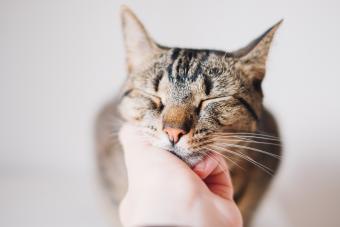
Research shows that 61 percent of pet cats are overweight or obese and should probably be on some type of weight loss plan. That doesn’t mean you can just put your cat on a diet, however. They need to get exercise, too.
But encouraging your indoor cat to exercise can be a real challenge. It’s not as easy as taking your kitty out for a walk like you might with a dog. So how can you exercise a cat? We have six great (and easy!) ways you can keep your indoor cat active and fit.
Why Exercise Is Important for Cats
Even though cats are inherently lazy creatures, they need exercise. Regular movement will help them maintain a healthy weight, which in itself can prevent debilitating health conditions like diabetes and arthritis, but it also helps strengthen their muscles, heart, and lungs.
Physical activity is also beneficial for a cat’s mental health. It can lower their stress and stave off boredom. The goal is to make exercise something enjoyable that your cat looks forward to, like playtime.
6 Exercises Your Cat Will Love
It's all about engagement. Give your cat a reason to do something, and they'll be excited while they play. You can get your cat moving by incorporating these simple games into your daily routine.
1. Try the Laser
Cats absolutely love lasers, and this toy is a fantastic way to give your cat a workout. Shine the laser a few inches in front of your cat and wiggle it a bit to entice them to chase the dot. As soon as they do, move it a bit further and further until you have your cat running around the entire room after the laser point.
Just don't overdo it with laser pointer play. Some cats who have very high prey drives — the desire to chase and capture prey — get frustrated and obsessive with laser pointers, because it's all "Chase" and no "Catch."
2. Use Teaser Wands
Cat wand toys can also get your cat running. You can find these in pet stores or even make them yourself. Just make sure it has something on the end that your cat loves, like a feather or piece of fuzzy fabric. Drag the wand around the house and prompt your cat to chase it.
You don’t want to take your cat from 0 to 60, so to speak, because this could result in injury. Slowly ease your cat into exercise and increase the duration or intensity as they build up their endurance.
3. Encourage Climbing
Cats love climbing, and it's a fantastic exercise for them. If you don’t already have a cat tree, get one now. You can encourage your cat to climb it by playing with a teaser wand on the tree or placing other toys on the top. Invite your cat to jump between the tree’s surfaces by moving your hands from surface-to-surface. This can be a fun bonding game, as well!
4. Get Them a Playmate

Solo cats may not be as active as those with buddies because they don’t have someone to play with. This is something you’ll want to consider carefully, but it could be helpful to get your cat a housemate. Bring a kitten or younger playmate into your home to keep your cat busy and chase around the house (in a playful way, of course). Just remember that it's a process introducing a new cat into your current cat's territory, so be cautious.
If you’re not ready for a second cat, why not set up a cat play date where your kitty can play with other cats?
5. Consider a Cat Wheel
Cat exercise wheels are the feline equivalent of a treadmill, but they do require some training. The first part involves getting your cat used to the wheel and teaching them how to use it. Some cats catch on quickly and absolutely love running in the wheel, whereas others would rather just lay on it. It’s best to incentivize the activity with treats and positive reinforcement.
If your cat is reluctant, lead them to the exercise wheel with a treat they love. First, just get them to put their paws on the wheel and treat them. Do this for a few days until your cat jumps into the wheel on their own. Then, hold the treat out in front of them, just out of reach, so they have to walk on the wheel to get the treat. Give them a ton of praise along with the treat. Keep this up until they are moving on the wheel by themselves.
6. Start Leash Training
We were just joking about the “not being able to take your cat for a walk” thing earlier because you actually can leash-walk your cat if you choose to. Many cats love exploring the outdoors, and this gives them a safe way to do it. You’ll first need to get your cat used to the harness, then slowly introduce them to the outdoors.
Cats aren't like dogs, in that most don't take to walking on a leash in the same way. Many cats don't respond to being pulled, so you have to be patient and take the time to work with them. Keep treats on hand and try to keep their attention as you lead them around. Walking your cat may not look like what you would expect. But it's great exercise for them, and it gets you both out of the house.
Cats should get between 15 and 30 minutes of exercise each day. Because cats are most active at dusk and dawn, aim to exercise them around those hours.
Make Cat Exercise Fun For Your Pet
Even though we can reason that the overall benefits of exercise outweigh the initial discomfort, it’s impossible to communicate that to your cat. Instead, you need to make their exercise fun. Disguise it as playtime, and never force your cat to exercise when they’re tired or just not feeling it. Brief periods of movement here and there throughout the day add up and can help extend their life.







